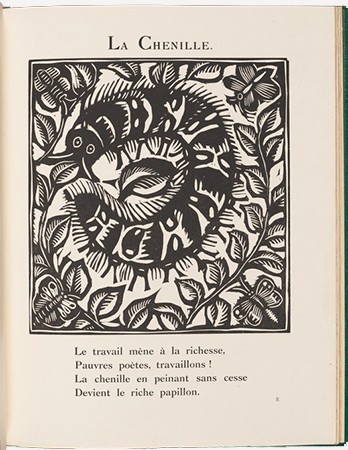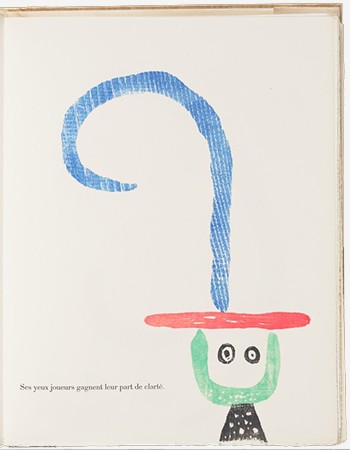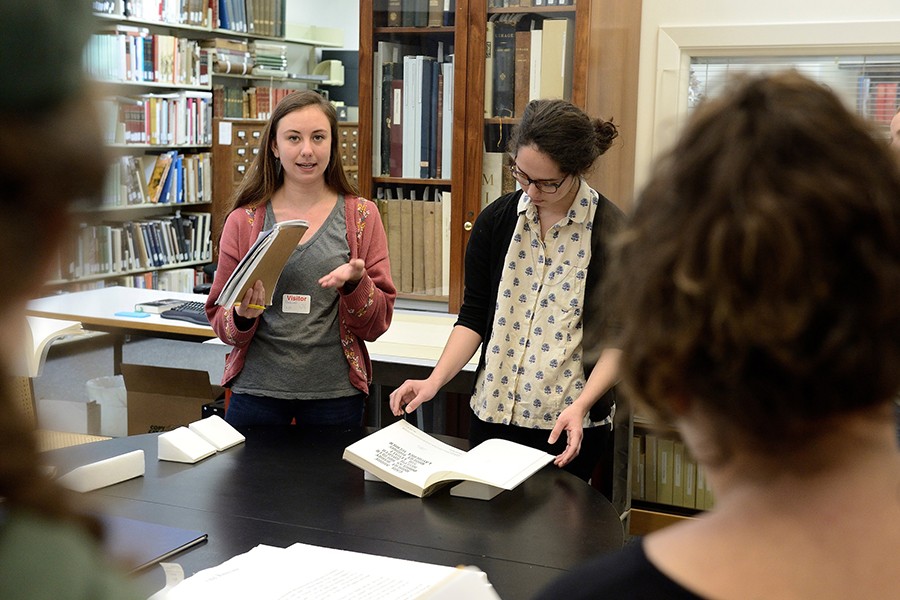Last spring, when Johns Hopkins University seniors Sarah Braver and Helena Arose enrolled in Paper Museums: Exhibiting Artists' Books at the Baltimore Museum of Art, neither had much familiarity with what an artist's book was, much less with how a museum launches an exhibit.

Image caption: Raoul Dufy and Guillaume Apollinaire. Page from the book Bestiary, or The Parade of Orpheus. 1911. The Baltimore Museum of Art: Nelson and Juanita Greif Gutman Fund, BMA 2013.226. © Raoul Dufy / Artists Rights Society (ARS), New York/ADAGP, Paris Henri.
One year later, Off the Shelf: Modern and Contemporary Artists' Books, a display of artists' books from the BMA's collection, reflects students' newfound knowledge as a result of this hands-on class. The exhibition, which opens Sunday and runs through June 25, is supported by a grant to the Program in Museums and Society at the Johns Hopkins University by the Andrew W. Mellon Foundation. Additional support has been provided by the National Endowment for the Arts and the Trust U/W of Helen M. Hughes.
Prized by collectors as singular collaborations between artists, publishers, and writers, artists' books, in their most basic form, are works of art in the form of a book.
"It's something of a balanced dialogue between image and text," says Rena Hoisington, BMA senior curator of prints, drawings, and photographs, and teacher of the Hopkins course.
"Off the Shelf" includes more than 100 rarely shown artists' books and related prints, including Bestiary or The Parade of Orpheus (1911), a striking collection of animal woodcuts by Raoul Dufy paired with poems by Guillaume Apollinaire; and My Pretty Pony, a collaboration between writer Stephen King and Barbara Kruger, notable for the digital time display mounted on the book's stainless steel cover. In all, works by more than 50 renowned artists—including Joan Miró, Pablo Picasso, Grace Hartigan, Ed Ruscha, and David Hockney—are on display.

Image caption: Joan Miró and Paul Éluard. Page from the book À Toute Épreuve. 1958. The Baltimore Museum of Art: Gift of Mrs. Nelson Gutman, in Memory of her Husband's Birthday, June 21st, BMA 1959.148. © Successió Miró / Artists Rights Society (ARS), New York / ADAGP, Paris 2017.
Throughout the semester-long class that is part of the Krieger School's Program in Museums and Society, 11 students—from Johns Hopkins, Loyola University Maryland, and the Maryland Institute College of Art—helped to determine the checklist and thematic organization of the exhibition. The students met with museum staff, including conservators, the exhibit designer, and marketing and education staff, to learn the behind-the-scenes logistics in mounting an exhibition. They also wrote the label texts for the books, an experience Braver, an art history major with a minor in museums and society, characterizes as initially challenging.
"You need to use technical language, but not too technical," she explains. "And it has to be concise; you need to include everything the reader needs to know in 150 words."
Braver and Arose look forward to giving tours of the exhibit, singling out their favorite artists' books (Tom Tit Tot, a collaboration between artist Susan Howe and poet R. H Quaytman for Braver; the work of photographer Ed Ruscha for Arose), and sharing their class' strategy for categorizing the display.
"I hope a takeaway for visitors would be that there are different ways you can experience art at the museum," says Arose. "And that art can come in many forms."
Posted in Arts+Culture
Tagged undergraduate research, program in museums and society









